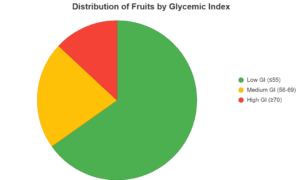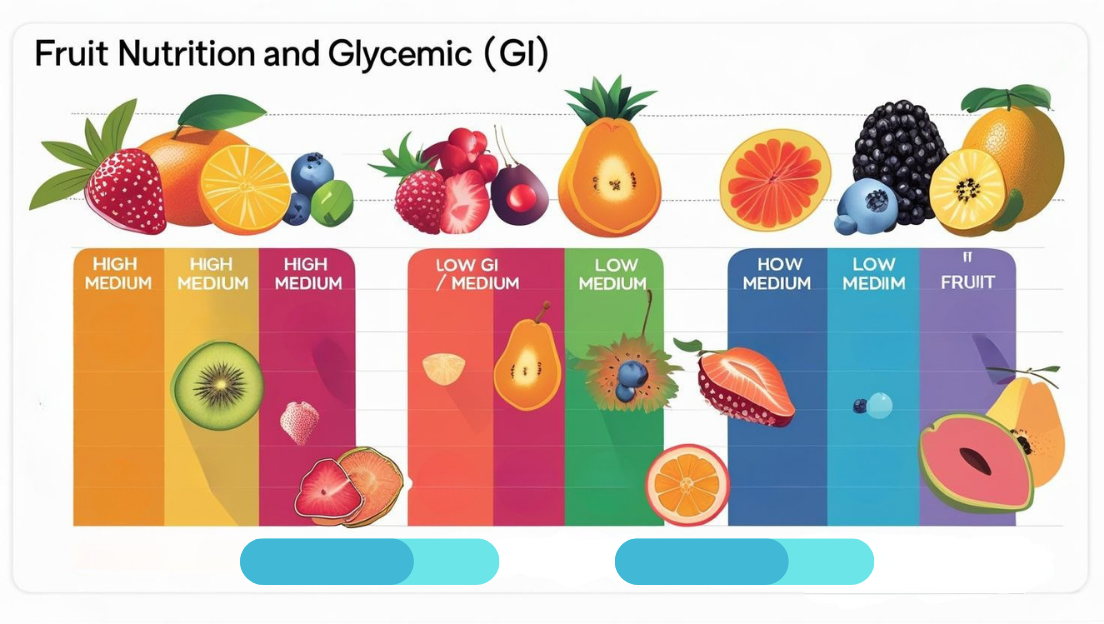Introduction
Welcome to our Indian fruits nutrition guide, your essential resource for healthy eating! For example, India’s diverse fruits like mangoes, guava, and apples provide vital nutrients for managing diabetes, blood pressure, and weight. This guide offers a detailed table of fruits, their glycemic index (GI), carbs, and health benefits. Furthermore, our infographic visualizes this data for easy decision-making. Whether you’re seeking low GI fruits or weight-friendly options, this nutrition guide for Indian fruits empowers you to choose wisely.
| Fruit Name | Hindi Name | GI Value | Carbohydrate (per 100g) | Seasonal Availability | Diabetes Suitability | BP Suitability | Weight Control |
|---|---|---|---|---|---|---|---|
| Apple | सेब (Seb) | 36–40 | 10.4g | Aug–Nov | Low (All) | Yes | Yes |
| Banana | केला (Kela) | 51–55 | 12.2g | Year-round | Medium (All) | Yes | Moderate |
| Mango | आम (Aam) | 51–56 | 14.8g | Apr–Jul | High (All) | Moderate | No |
| Orange | संतरा (Santra) | 40–45 | 8.2g | Oct–Mar | Low (All) | Yes | Yes |
| Grapes | अंगूर (Angoor) | 43–53 | 16.3g | Feb–Apr, Sep | High (All) | Moderate | No |
| Pineapple | अनानास (Ananas) | 59–66 | 16.3g | Mar–Jul | High (All) | Moderate | No |
| Watermelon | तरबूज (Tarbooj) | 72 | 6.2g | Mar–Jun | High (All) | Yes | Yes |
| Papaya | पपीता (Papita) | 60–65 | 8.3g | Year-round | Medium (All) | Yes | Yes |
| Guava | अमरूद (Amrud) | 14–20 | 5.4g | Oct–Mar | Low (All) | Yes | Yes |
| Pomegranate | अनार (Anar) | 53 | 9.2g | Sep–Mar | Medium (All) | Yes | Moderate |
| Strawberry | स्ट्रॉबेरी | 40 | 4.9g | Dec–Mar | Low (All) | Yes | Yes |
| Blueberry | ब्लूबेरी | 40 | 9.9g | Dec–Mar | Low (All) | Yes | Yes |
| Blackberry | जामुन (Jamun) | 25–30 | 4.9g | Jun–Aug | Low (All) | Yes | Yes |
| Kiwi | कीवी (Kiwi) | 47–53 | 9.2g | Nov–Jan | Low–Medium (All) | Yes | Yes |
| Apricot | खुबानी | 34 | 9.2g | May–Jul | Low (All) | Yes | Yes |
| Plum | आलूबुखारा | 39 | 9.9g | Jun–Aug | Low (All) | Yes | Yes |
| Peach | आड़ू (Aadu) | 42 | 8.4g | Jul–Aug | Low (All) | Yes | Yes |
| Coconut | नारियल (Nariyal) | 42 | 6.2g | Year-round | Low (All) | Yes | Moderate |
| Lemon | नींबू (Nimbu) | 20 | 2.5g | Year-round | Low (All) | Yes | Yes |
| Pear | नाशपाती | 38–42 | 9.8g | Aug–Oct | Low (All) | Yes | Yes |
| Lychee | लीची (Lychee) | 50–55 | 16.5g | May–Jul | High (All) | Moderate | No |
| Cherries | चेरी (Cherry) | 22 | 8.0g | May–Jul | Low (All) | Yes | Yes |
| Starfruit | कमरख (Kamrakh) | 23 | 4.2g | Sep–Apr | Low (All) | Yes | Yes |
| Custard Apple | शरीफा (Sharifa) | 54–60 | 14.3g | Sep–Dec | Medium–High (All) | Moderate | No |
| Fig | अंजीर (Anjeer) | 51–61 | 16.3g | Jun–Sep | High (All) | Moderate | No |
| Gooseberry | आंवला (Amla) | 15–20 | 4.4g | Oct–Mar | Low (All) | Yes | Yes |
| Grapefruit | चकोतरा | 25 | 6.9g | Nov–Mar | Low (All) | Yes | Yes |
| Muskmelon | खरबूजा | 65 | 8.0g | Apr–Jun | Medium–High (All) | Yes | Yes |
| Jackfruit | कटहल (Kathal) | 50–60 | 23.0g | May–Jul | High (All) | Moderate | No |
| Avocado | मक्खनफल | 15 | 9.0g | Jul–Sep | Low (All) | Yes | Yes |

Relevance and Importance of Glycemic Index (GI)
The glycemic index (GI) is a numerical scale (0-100) that measures how quickly a carbohydrate-containing food raises blood sugar levels after consumption. Foods are categorized as:
- Low GI (≤55): Slow digestion and absorption, leading to gradual blood sugar increases.
- Medium GI (56-69): Moderate impact on blood sugar.
- High GI (≥70): Rapid digestion, causing quick blood sugar spikes.
Why GI Matters
Low GI fruits in our Indian fruits nutrition guide offer multiple health benefits. For example-
- Diabetes Management: Research suggests that for individuals with Type 1, Type 2, or pre-diabetes, low GI foods help maintain stable blood sugar levels, reducing the risk of hyperglycemia (high blood sugar) or hypoglycemia (low blood sugar). For example, fruits like guava (GI 29) and apples (GI 36) are excellent choices, while watermelon (GI 76) should be consumed in moderation .
- Weight Control: Low GI foods, often high in fiber, promote satiety, reducing hunger and overall calorie intake. This is beneficial for weight management, as seen with fruits like strawberries (GI 25) and oranges (GI 35), which are low in calories and high in fiber.
- Heart Health: A diet rich in low GI foods is associated with a lower risk of heart disease due to improved insulin sensitivity and cholesterol levels .
Why Consider GI?
Personalized Nutrition: GI helps individuals tailor their diet to specific health needs, such as diabetes management or weight loss.
Balanced Diet: GI complements other nutritional factors like fiber, vitamins, and minerals, ensuring a well-rounded diet.
Preventive Health: Even for non-diabetics, low GI foods contribute to stable energy levels and may reduce the risk of insulin resistance or metabolic syndrome.
Additional Health Considerations
Blood Pressure Management
Most fruits are naturally low in sodium and high in potassium, making them excellent choices for managing blood pressure. Potassium helps counteract the effects of sodium, reducing blood vessel tension. Fruits like bananas, oranges, and guava are particularly rich in potassium, supporting heart health. Even high-calorie fruits like coconut, despite their saturated fat content, provide potassium and can be included in moderation.
Weight Control
For weight management, choosing low-calorie, high-fiber fruits is key. Fruits like watermelon (30 calories/100g), strawberries (32 calories/100g), and lemons (29 calories/100g) are ideal for weight control due to their low calorie density and high water content, which promotes satiety. Higher-calorie fruits like bananas (90 calories/100g) and mangoes (60 calories/100g) can still be part of a weight loss diet if consumed in controlled portions.
Seasonal Availability
Opting for seasonal fruits ensures maximum freshness and nutritional value. For example, mangoes and lychees are at their peak in summer, while oranges and guavas shine in winter. Year-round fruits like apples, bananas, and papayas provide consistent options for a balanced diet. Seasonal eating also supports local agriculture and reduces reliance on imported or preserved fruits, which may lose nutritional value.
Wrapping Up … !
India’s rich fruit diversity offers something for everyone, whether you’re managing diabetes, blood pressure, or weight. By understanding the glycemic index, carbohydrate content, and seasonal availability of fruits, you can make informed choices that align with your health goals. Low GI fruits like apples, guava, and strawberries are excellent for blood sugar control, while most fruits support blood pressure management due to their potassium content. For weight control, prioritize low-calorie, high-fiber options like watermelon and oranges.
**With your growing understanding of fruits and their benefits, you can take your healthy lifestyle to the next level! Try our AI-Powered Diet Chart, designed to create a balanced meal plan tailored to your unique health needs – and get started on your personalized journey to better health.
**This blog is for informational purposes only. Enjoy a variety of fresh, seasonal fruits as part of a balanced diet, but always consult your healthcare provider for advice tailored to your specific health needs.






